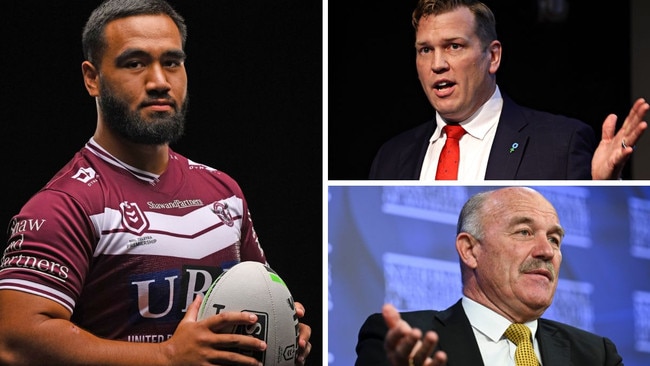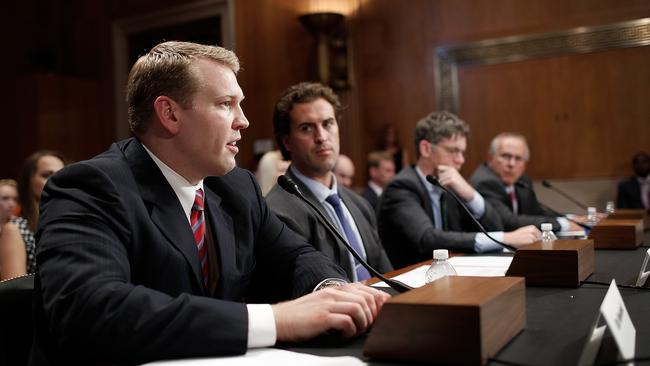Calls to ban tackle after ‘frightening’ CTE diagnosis in NRL rookie
Keith Titmuss’s CTE revelation has triggered calls to ban tackling in junior football. But rugby league Immortal Wally Lewis says there is ‘no game’ if the proposal goes ahead.

Calls for tackling in junior footy to be scrapped have been triggered following news that NRL rookie Keith Titmuss was suffering chronic traumatic encephalopathy when he died at 20 – the youngest Australian sport player to be diagnosed with the head-knock-related condition.
Yet as sports neuroscientists are pushing for limiting contact at junior levels, rugby league immortal Wally Lewis, while appealing for better safety for young athletes, doesn’t believe tackling needs to go.
Lewis, who is suffering early on-set dementia believed to be caused by his 14-year footy career, is vocal about ridding the game of dangerous plays aimed at the head but says there is no rugby league if tackling is banned at the junior level.
“I understand that [idea] but my point is what happens when you get rid of tackling – there is no game,” Lewis, 64, said.
“You can’t have a game when there is no tackling ... that sort of football is called touch football.
“I understand there are parents that just insist that’s the sport their kids are going to play.”
Lewis said: “You’re never going to be able to take the contact, the body contact, out of the game. People are searching for a level of perfection that doesn’t exist.
“I am calling for a safer game, all of the guys would love to see that. How do you do that? The only thing most players demand is that if there is full contact made with the head, there should be no sympathy shown whatsoever. There should be harsh penalties delivered.”
CTE is a concern for a range of contact sports.
It is a neurodegenerative disease associated with repeated head injuries, concussions or subconcussions and has been found post-mortem in footballers such as St Kilda AFL great Danny Frawley and decorated rugby league player Paul Green.

Titmuss, who played representative junior rugby league and union including for Sydney private school Newington College, was diagnosed with stage two CTE (there are four stages).
“It is a wake-up, but they certainly are already aware [of head injury issues],” Lewis said, of Titmuss’s diagnosis.
The diagnosis – made after Titmuss died of exertional heat stroke following a 2020 Manly Sea Eagles training session and until now not disclosed – has sparked warnings that the major football codes are not doing enough to protect young athletes.
Michael Buckland of the Australian Sports Brain Bank, who discovered Titmuss’s CTE post-mortem, has previously called for all collision sports to limit contact in training and encouraged non-contact in those under the age of 13.
Neuroscientist Chris Nowinski, a former professional wrestler who also played college football at Harvard, said Titmuss’s CTE diagnosis should be a “call to action” to eliminate tackling for kids under 14.
Nowinski noted that the US’s youngest CTE case was an American football player named Wyatt Bramwell, who died by suicide at 18 and began playing at eight.
Like Titmuss, Bramwell also had stage two CTE.
“It is sad to see another young man found to have stage 2 CTE at such a young age,” Nowinski said.
“Even though Keith didn’t die of CTE, CTE is not a benign disease.

“As the disease advances, it can cause dementia.
“Because CTE is caused by repetitive head impacts, I hope this results in a call to action to reduce repetitive head impacts for young athletes.
“Codes cannot say they are taking this seriously enough until they have a written CTE Prevention Protocol alongside their concussion protocols,” Nowinski said.
“Children should not be exposed to the same risks as adults. The benefits are smaller, and they can’t provide informed consent, so they should not have similar exposure to head impacts.
“The youth version of any sport should eliminate repetitive head impacts at least until children are 14.”
Nowinski, who last competed in World Wrestling Entertainment, the American professional wrestling promotion, as Chris Havard in 2003, has become one of the more prominent voices for concussion awareness in the world.



